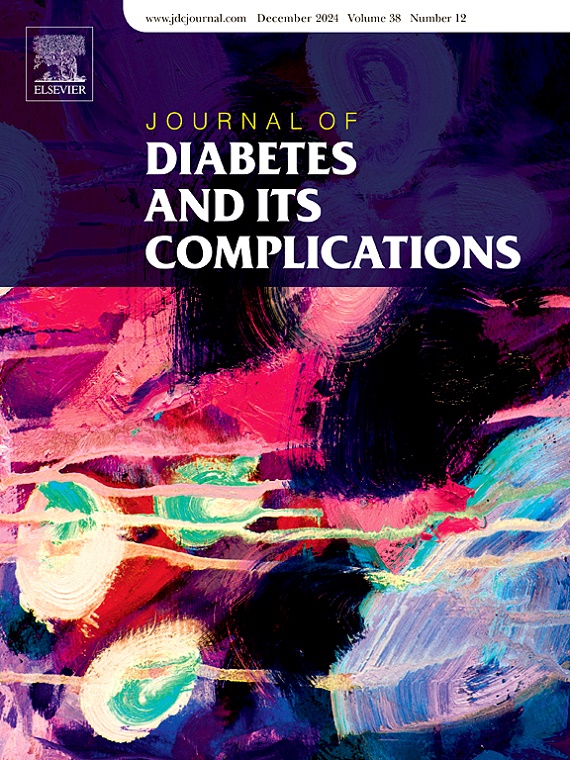A retrospective study to investigate the risk factors for gestational diabetes mellitus and its impact on maternal and neonatal outcomes
IF 3.1
3区 医学
Q3 ENDOCRINOLOGY & METABOLISM
引用次数: 0
Abstract
Background
Currently, risk factors for gestational diabetes mellitus (GDM) and its impact on maternal and neonatal outcomes have not been fully elucidated. Therefore, we performed a retrospective epidemiologic study to explore the above research objectives.
Methods
We collected extensive clinical data from January 2020 to June 2023 for 855 maternity cases at the Department of Obstetrics and Gynecology, Chaoyang Hospital, Capital Medical University. Vitamin D deficiency, undergoing assisted reproductive techniques, advanced maternal age (≥35), multiparas, abortion history, pre-pregnancy body mass index (≥25.0), twin pregnancy, polycystic ovary syndrome (PCOS), family history of diabetes, history of delivering a low-birth-weight infant, and weight gain during gestation of >2 kg per month (mean) as variables that may affect GDM to investigate the risk factors for GDM. In addition, a total of 15 adverse postpartum outcomes (including maternal complications and neonatal complications) were used to explore the adverse effects of maternal comorbidity with GDM. Variables that were significant in the univariate logistic regression model were included in the multivariate logistic regression model. Receiver operating characteristic (ROC) curves were conducted for the ability to predict the risk of the GDM and its impact on maternal and neonatal outcomes, using variables derived from the multivariate logistic regression models.
Results
The results of multivariate logistic regression analyses shown that only multipara was not a risk factor for the development of GDM. Postpartum hemorrhage (blood loss ≥500 ml) and the neonatal Apgar score (≤9) (all P > 0.05) was excluded in the multivariate logistic regression model. According to the results of multivariate logistic regression analyses, the incidence of hypothyroid complications, hyperlipidemic complications, postpartum anemia, gestational hypertension, racket placenta, premature rupture of membranes, fetal malposition, macrosomia (≥4000 g), low-birth-weight infants (<2500 g), prematurity, neonatal infections, neonatal jaundice, and fetal distress was higher in pregnancies with combined GDM (all P < 0.05). The model demonstrated excellent diagnostic performance, with an area under the ROC curve of 0.91, indicating its efficacy in predicting adverse prognostic outcomes associated with maternal GDM.
Conclusions
It is essential for women of childbearing age to correct vitamin D deficiency as well as to maintain their body mass index within the normal range before preparing for pregnancy. Maternal weight gain needs to be managed appropriately throughout pregnancy, which may reduce the risk of GDM to some extent. Therefore, our results suggest that effective measures to reduce the risk of GDM are essential for both the mother and the newborn.
回顾性研究妊娠期糖尿病的危险因素及其对孕产妇和新生儿预后的影响
背景目前,妊娠期糖尿病(GDM)的风险因素及其对产妇和新生儿结局的影响尚未完全阐明。因此,我们进行了一项回顾性流行病学研究,以探讨上述研究目标。方法我们收集了首都医科大学附属北京朝阳医院妇产科 2020 年 1 月至 2023 年 6 月期间 855 例孕产妇的大量临床资料。将维生素 D 缺乏、接受辅助生殖技术、高龄产妇(≥35 岁)、多胎妊娠、人工流产史、孕前体重指数(≥25.0)、双胎妊娠、多囊卵巢综合征(PCOS)、糖尿病家族史、低体重儿分娩史、妊娠期体重增长每月平均 2 千克等作为可能影响 GDM 的变量,研究 GDM 的危险因素。此外,还采用了共 15 项产后不良后果(包括产妇并发症和新生儿并发症)来探讨产妇合并 GDM 的不良影响。在单变量逻辑回归模型中显著的变量被纳入多变量逻辑回归模型。结果多变量逻辑回归分析结果显示,只有多胎妊娠不是 GDM 发生的风险因素。多变量逻辑回归模型排除了产后出血(失血量≥500 ml)和新生儿 Apgar 评分(≤9 分)(均为 P > 0.05)。根据多变量逻辑回归分析结果,甲状腺功能减退并发症、高脂血症并发症、产后贫血、妊娠高血压、胎盘早剥、胎膜早破、胎位不正、巨大儿(≥4000 g)、低体重儿(<;2500 g)、早产儿、新生儿感染、新生儿黄疸和胎儿窘迫在合并 GDM 的孕妇中发生率更高(均 P < 0.05).该模型具有良好的诊断性能,其 ROC 曲线下面积为 0.91,表明它能有效预测与孕产妇 GDM 相关的不良预后结果。在整个孕期,孕产妇的体重增加需要得到适当控制,这可能会在一定程度上降低 GDM 的风险。因此,我们的研究结果表明,有效降低 GDM 风险的措施对母亲和新生儿都至关重要。
本文章由计算机程序翻译,如有差异,请以英文原文为准。
求助全文
约1分钟内获得全文
求助全文
来源期刊

Journal of diabetes and its complications
医学-内分泌学与代谢
CiteScore
5.90
自引率
3.30%
发文量
153
审稿时长
16 days
期刊介绍:
Journal of Diabetes and Its Complications (JDC) is a journal for health care practitioners and researchers, that publishes original research about the pathogenesis, diagnosis and management of diabetes mellitus and its complications. JDC also publishes articles on physiological and molecular aspects of glucose homeostasis.
The primary purpose of JDC is to act as a source of information usable by diabetes practitioners and researchers to increase their knowledge about mechanisms of diabetes and complications development, and promote better management of people with diabetes who are at risk for those complications.
Manuscripts submitted to JDC can report any aspect of basic, translational or clinical research as well as epidemiology. Topics can range broadly from early prediabetes to late-stage complicated diabetes. Topics relevant to basic/translational reports include pancreatic islet dysfunction and insulin resistance, altered adipose tissue function in diabetes, altered neuronal control of glucose homeostasis and mechanisms of drug action. Topics relevant to diabetic complications include diabetic retinopathy, neuropathy and nephropathy; peripheral vascular disease and coronary heart disease; gastrointestinal disorders, renal failure and impotence; and hypertension and hyperlipidemia.
 求助内容:
求助内容: 应助结果提醒方式:
应助结果提醒方式:


